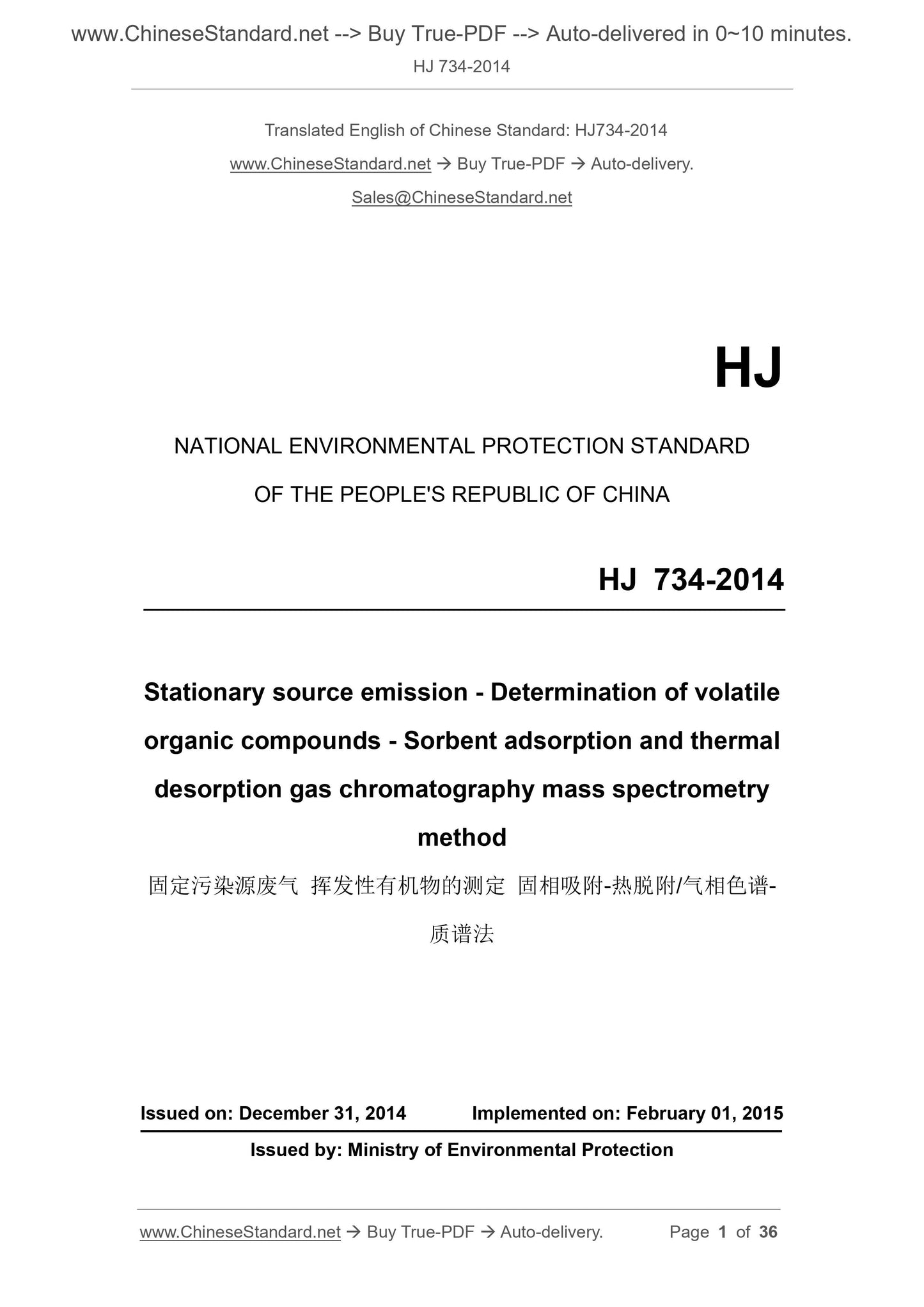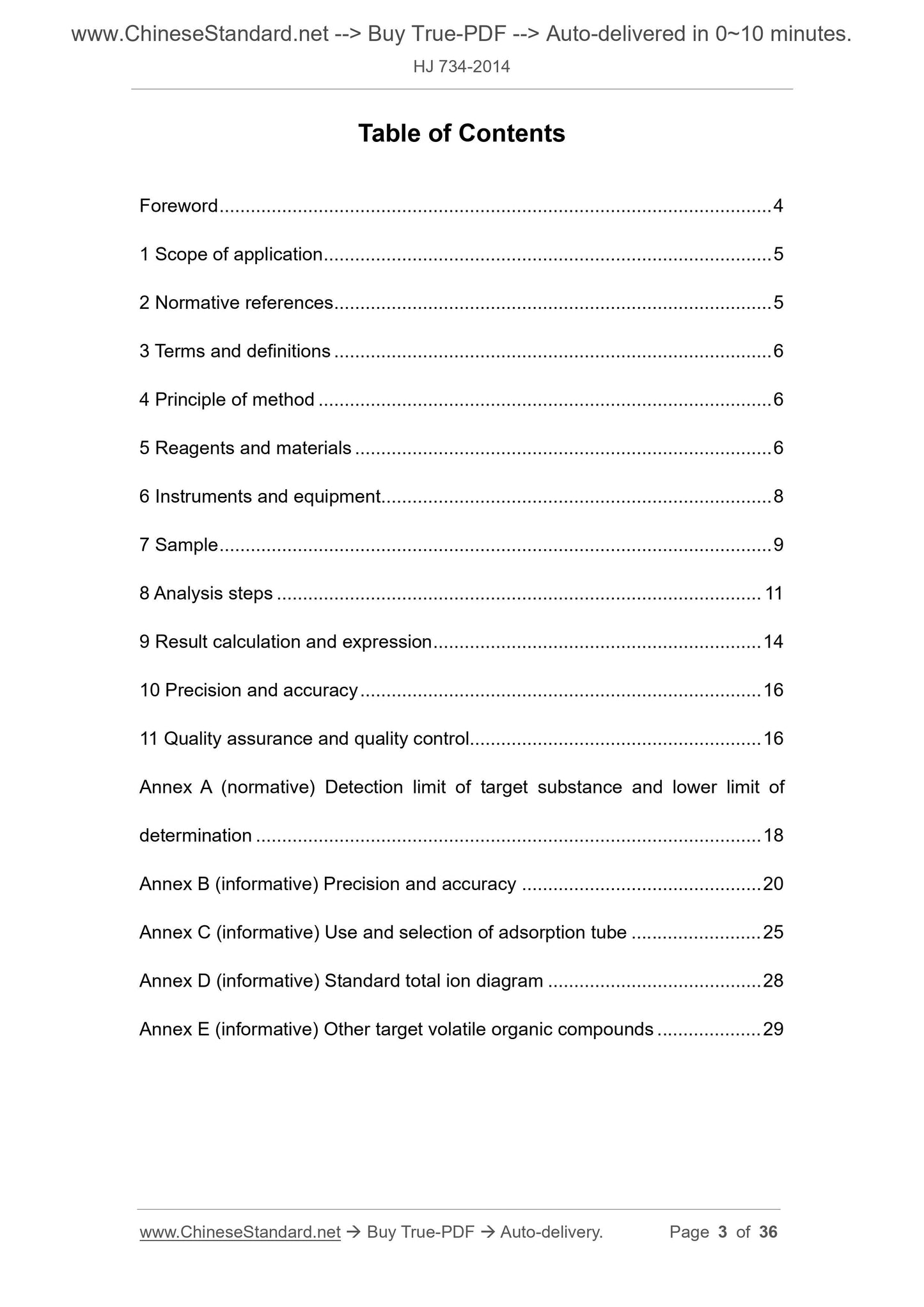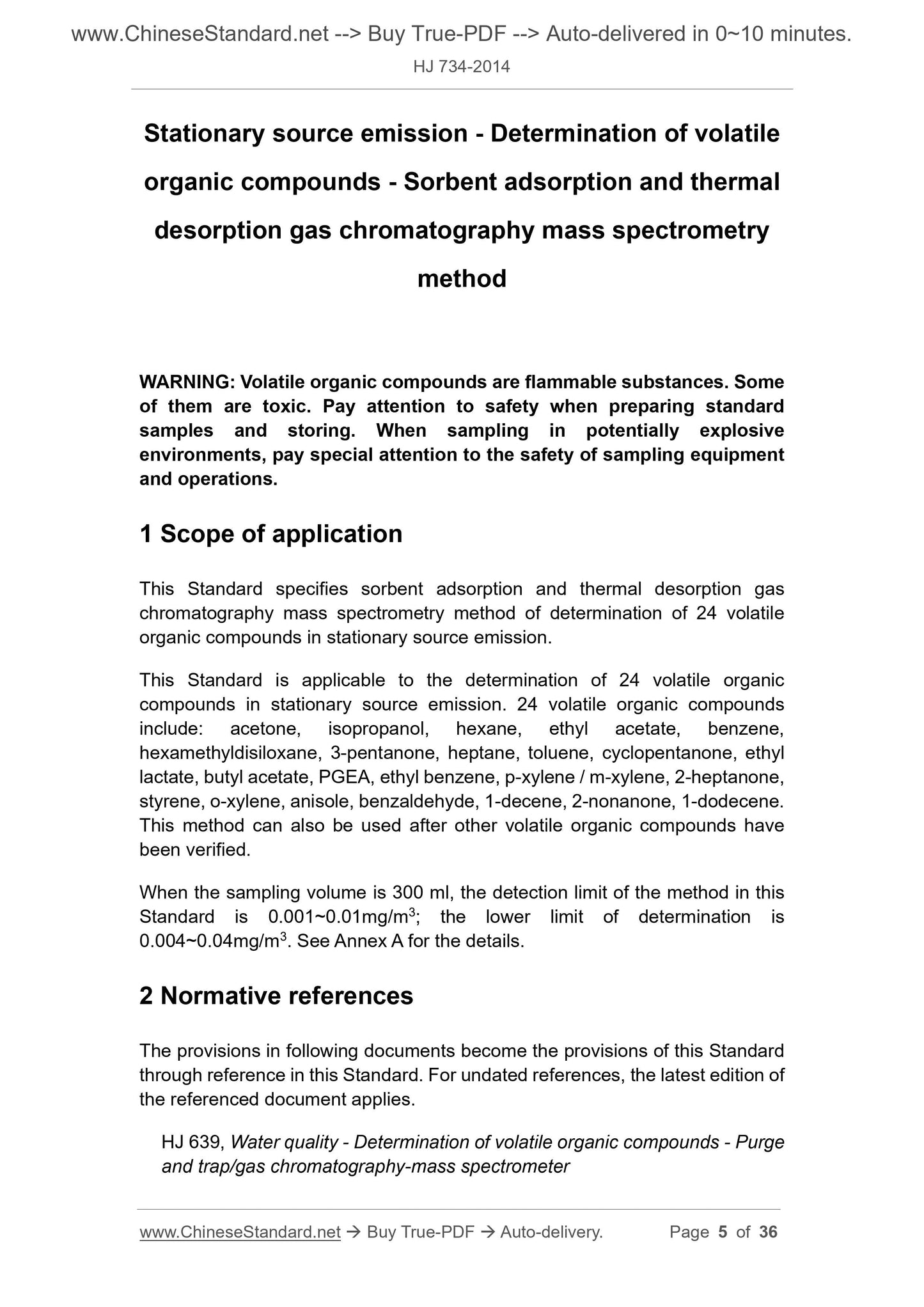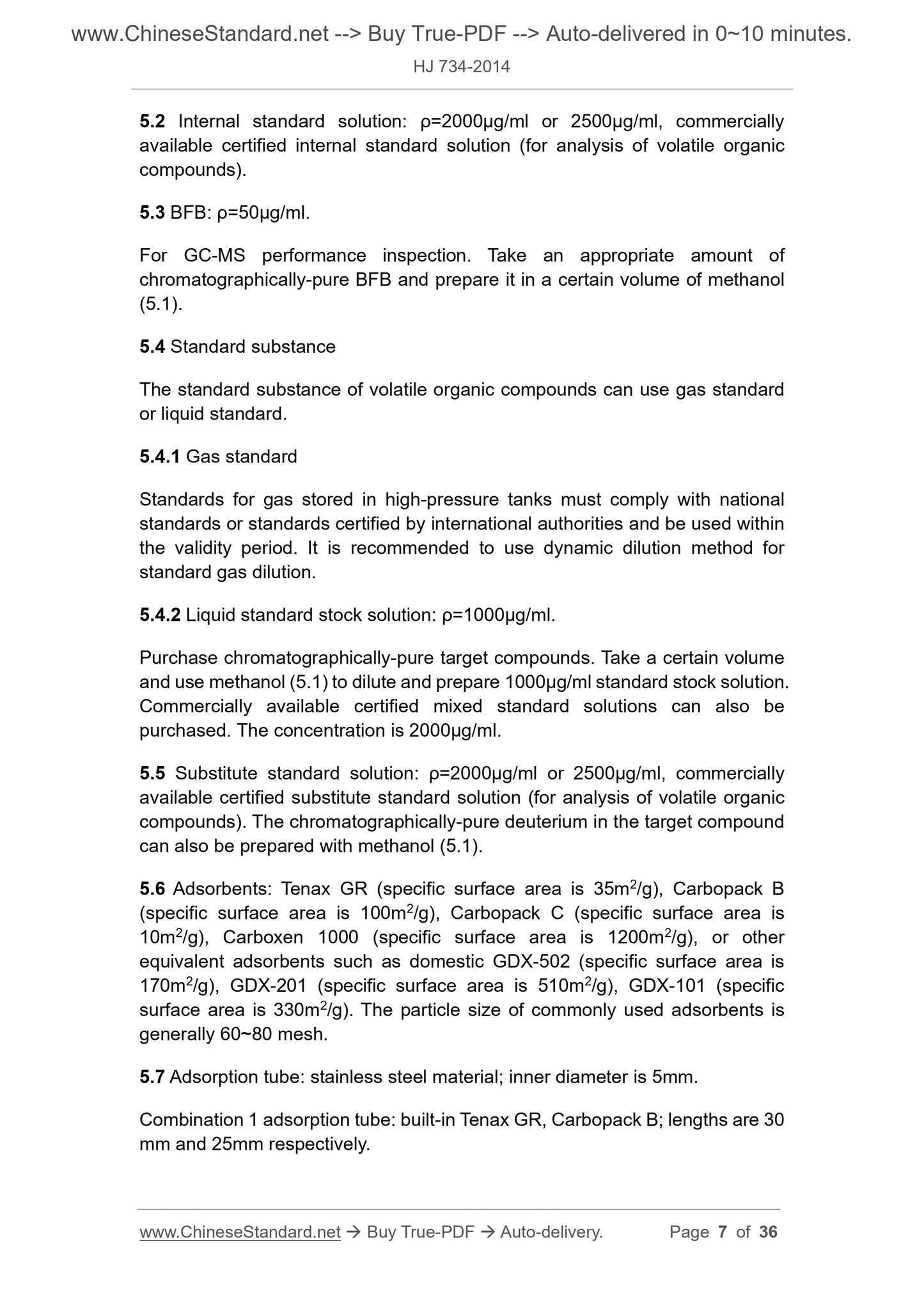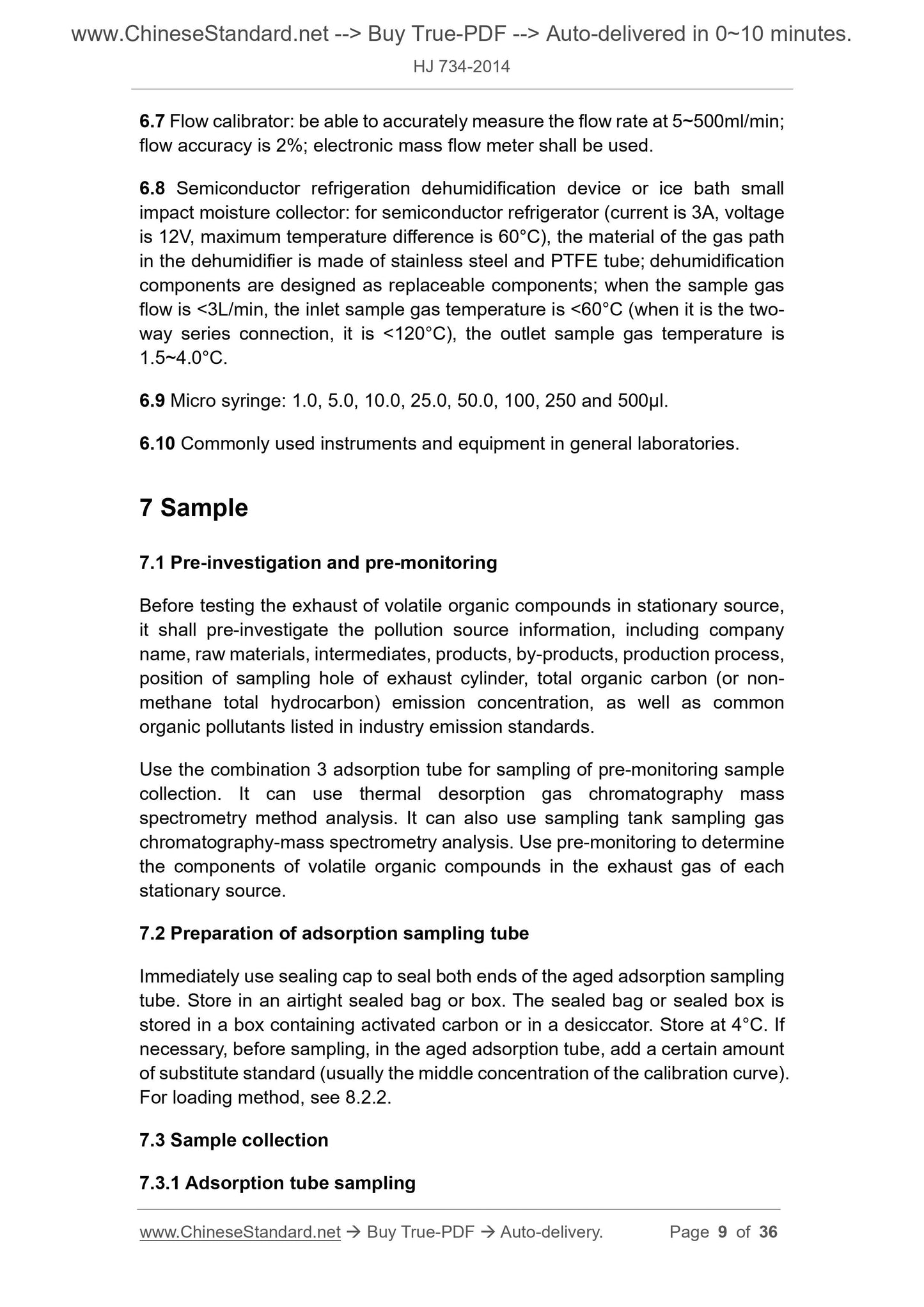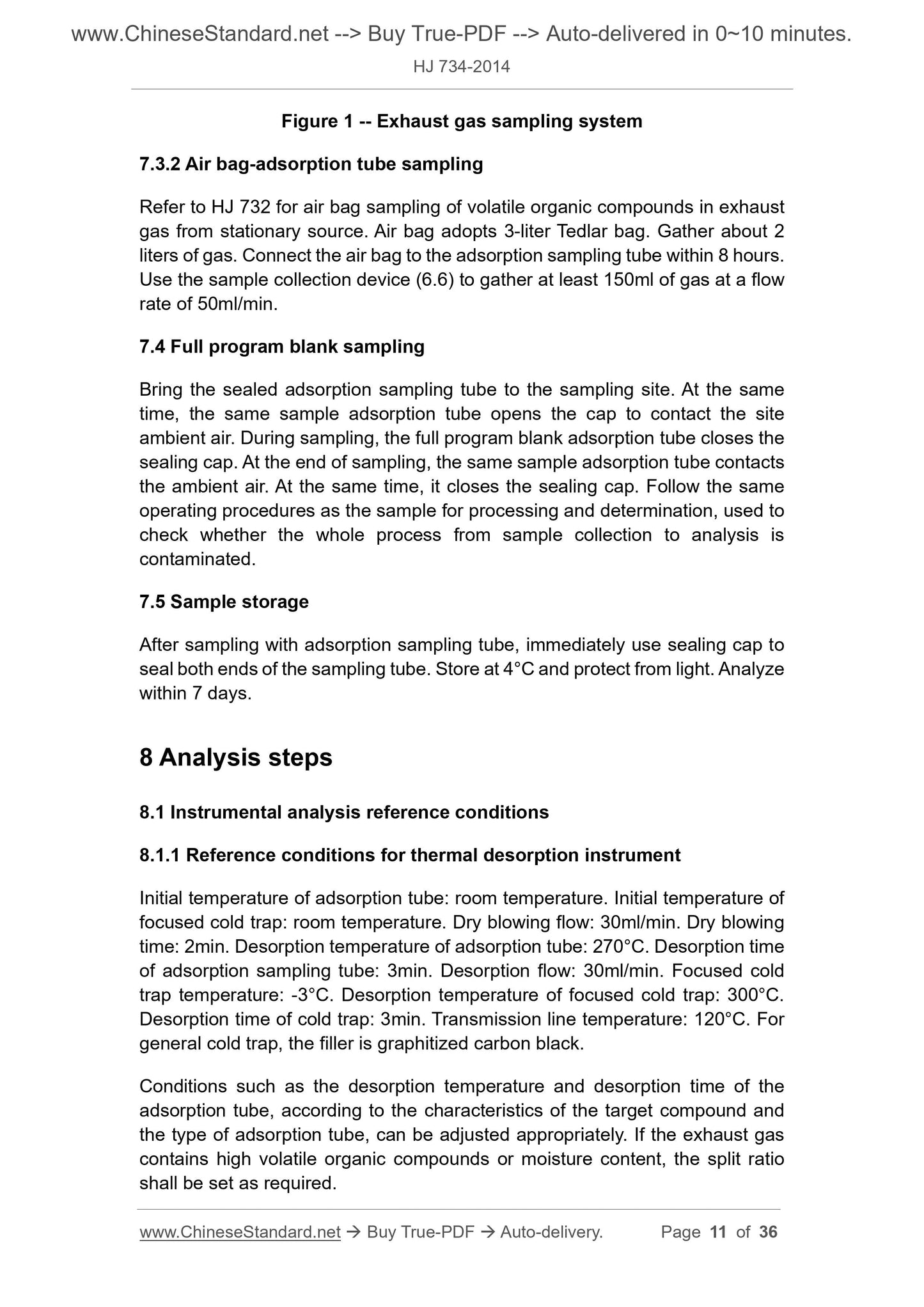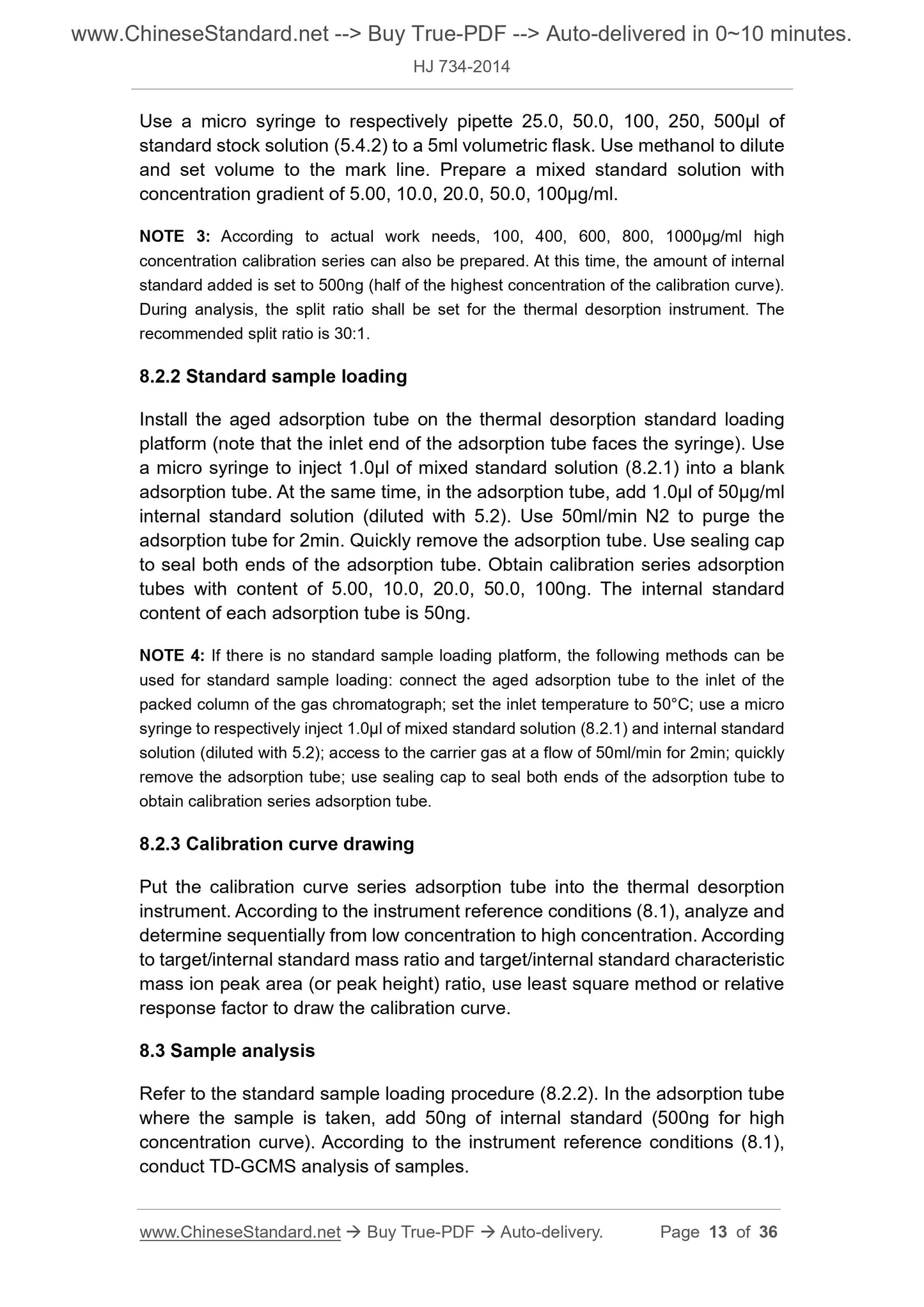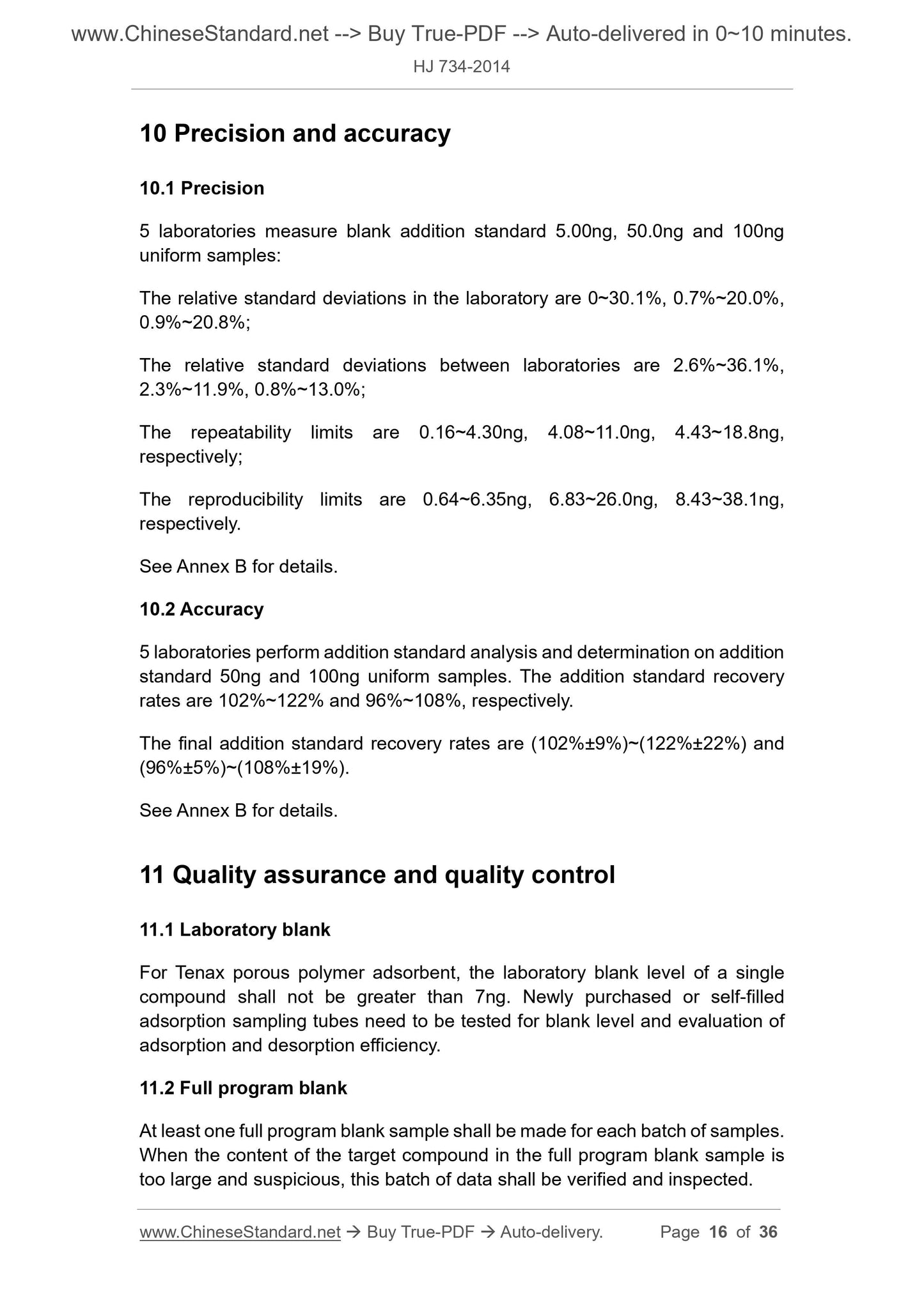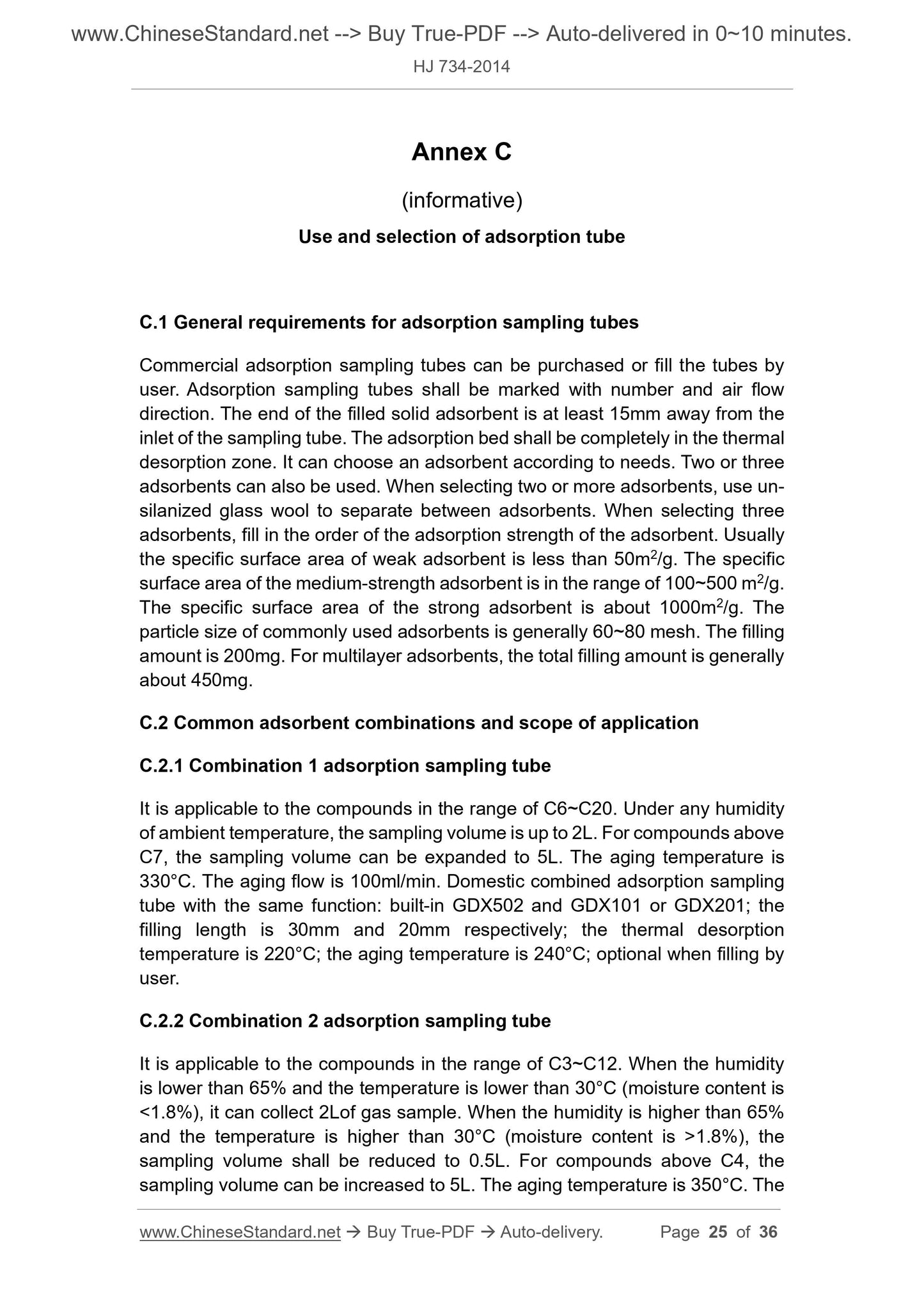1
/
of
9
www.ChineseStandard.us -- Field Test Asia Pte. Ltd.
HJ 734-2014 English PDF
HJ 734-2014 English PDF
Regular price
$165.00
Regular price
Sale price
$165.00
Unit price
/
per
Shipping calculated at checkout.
Couldn't load pickup availability
HJ 734-2014: Stationary source emission - Determination of volatile organic compounds - Sorbent adsorption and thermal desorption gas chromatography mass spectrometry method
Delivery: 9 seconds. Download (& Email) true-PDF + Invoice.
Get Quotation: Click HJ 734-2014 (Self-service in 1-minute)
Historical versions (Master-website): HJ 734-2014
Preview True-PDF (Reload/Scroll-down if blank)
HJ 734-2014
HJ
NATIONAL ENVIRONMENTAL PROTECTION STANDARD
OF THE PEOPLE'S REPUBLIC OF CHINA
Stationary source emission - Determination of volatile
organic compounds - Sorbent adsorption and thermal
desorption gas chromatography mass spectrometry
method
ISSUED ON: DECEMBER 31, 2014
IMPLEMENTED ON: FEBRUARY 01, 2015
Issued by: Ministry of Environmental Protection
Table of Contents
Foreword ... 4
1 Scope of application ... 5
2 Normative references ... 5
3 Terms and definitions ... 6
4 Principle of method ... 6
5 Reagents and materials ... 6
6 Instruments and equipment... 8
7 Sample ... 9
8 Analysis steps ... 11
9 Result calculation and expression ... 14
10 Precision and accuracy ... 16
11 Quality assurance and quality control... 16
Annex A (normative) Detection limit of target substance and lower limit of
determination ... 18
Annex B (informative) Precision and accuracy ... 20
Annex C (informative) Use and selection of adsorption tube ... 25
Annex D (informative) Standard total ion diagram ... 28
Annex E (informative) Other target volatile organic compounds ... 29
Stationary source emission - Determination of volatile
organic compounds - Sorbent adsorption and thermal
desorption gas chromatography mass spectrometry
method
WARNING: Volatile organic compounds are flammable substances. Some
of them are toxic. Pay attention to safety when preparing standard
samples and storing. When sampling in potentially explosive
environments, pay special attention to the safety of sampling equipment
and operations.
1 Scope of application
This Standard specifies sorbent adsorption and thermal desorption gas
chromatography mass spectrometry method of determination of 24 volatile
organic compounds in stationary source emission.
This Standard is applicable to the determination of 24 volatile organic
compounds in stationary source emission. 24 volatile organic compounds
include: acetone, isopropanol, hexane, ethyl acetate, benzene,
hexamethyldisiloxane, 3-pentanone, heptane, toluene, cyclopentanone, ethyl
lactate, butyl acetate, PGEA, ethyl benzene, p-xylene / m-xylene, 2-heptanone,
styrene, o-xylene, anisole, benzaldehyde, 1-decene, 2-nonanone, 1-dodecene.
This method can also be used after other volatile organic compounds have
been verified.
When the sampling volume is 300 ml, the detection limit of the method in this
Standard is 0.001~0.01mg/m3; the lower limit of determination is
0.004~0.04mg/m3. See Annex A for the details.
2 Normative references
The provisions in following documents become the provisions of this Standard
through reference in this Standard. For undated references, the latest edition of
the referenced document applies.
HJ 639, Water quality - Determination of volatile organic compounds - Purge
and trap/gas chromatography-mass spectrometer
5.2 Internal standard solution: ρ=2000μg/ml or 2500μg/ml, commercially
available certified internal standard solution (for analysis of volatile organic
compounds).
5.3 BFB: ρ=50μg/ml.
For GC-MS performance inspection. Take an appropriate amount of
chromatographically-pure BFB and prepare it in a certain volume of methanol
(5.1).
5.4 Standard substance
The standard substance of volatile organic compounds can use gas standard
or liquid standard.
5.4.1 Gas standard
Standards for gas stored in high-pressure tanks must comply with national
standards or standards certified by international authorities and be used within
the validity period. It is recommended to use dynamic dilution method for
standard gas dilution.
5.4.2 Liquid standard stock solution: ρ=1000μg/ml.
Purchase chromatographically-pure target compounds. Take a certain volume
and use methanol (5.1) to dilute and prepare 1000μg/ml standard stock solution.
Commercially available certified mixed standard solutions can also be
purchased. The concentration is 2000μg/ml.
5.5 Substitute standard solution: ρ=2000μg/ml or 2500μg/ml, commercially
available certified substitute standard solution (for analysis of volatile organic
compounds). The chromatographically-pure deuterium in the target compound
can also be prepared with methanol (5.1).
5.6 Adsorbents: Tenax GR (specific surface area is 35m2/g), Carbopack B
(specific surface area is 100m2/g), Carbopack C (specific surface area is
10m2/g), Carboxen 1000 (specific surface area is 1200m2/g), or other
equivalent adsorbents such as domestic GDX-502 (specific surface area is
170m2/g), GDX-201 (specific surface area is 510m2/g), GDX-101 (specific
surface area is 330m2/g). The particle size of commonly used adsorbents is
generally 60~80 mesh.
5.7 Adsorption tube: stainless steel material; inner diameter is 5mm.
Combination 1 adsorption tube: built-in Tenax GR, Carbopack B; lengths are 30
mm and 25mm respectively.
6.7 Flow calibrator: be able to accurately measure the flow rate at 5~500ml/min;
flow accuracy is 2%; electronic mass flow meter shall be used.
6.8 Semiconductor refrigeration dehumidification device or ice bath small
impact moisture collector: for semiconductor refrigerator (current is 3A, voltage
is 12V, maximum temperature difference is 60°C), the material of the gas path
in the dehumidifier is made of stainless steel and PTFE tube; dehumidification
components are designed as replaceable components; when the sample gas
flow is < 3L/min, the inlet sample gas temperature is < 60°C (when it is the two-
way series connection, it is < 120°C), the outlet sample gas temperature is
1.5~4.0°C.
6.9 Micro syringe: 1.0, 5.0, 10.0, 25.0, 50.0, 100, 250 and 500μl.
6.10 Commonly used instruments and equipment in general laboratories.
7 Sample
7.1 Pre-investigation and pre-monitoring
Before testing the exhaust of volatile organic compounds in stationary source,
it shall pre-investigate the pollution source information, including company
name, raw materials, intermediates, products, by-products, production process,
position of sampling hole of exhaust cylinder, total organic carbon (or non-
methane total hydrocarbon) emission concentration, as well as common
organic pollutants listed in industry emission standards.
Use the combination 3 adsorption tube for sampling of pre-monitoring sample
collection. It can use thermal desorption gas chromatography mass
spectrometry method analysis. It can also use sampling tank sampling gas
chromatography-mass spectrometry analysis. Use pre-monitoring to determine
the components of volatile organic compounds in the exhaust gas of each
stationary source.
7.2 Preparation of adsorption sampling tube
Immediately use sealing cap to seal both ends of the aged adsorption sampling
tube. Store in an airtight sealed bag or box. The sealed bag or sealed box is
stored in a box containing activated carbon or in a desiccator. Store at 4°C. If
necessary, before sampling, in the aged adsorption tube, add a certain amount
of substitute standard (usually the middle concentration of the calibration curve).
For loading method, see 8.2.2.
7.3 Sample collection
7.3.1 Adsorption tube sampling
Figure 1 -- Exhaust gas sampling system
7.3.2 Air bag-adsorption tube sampling
Refer to HJ 732 for air bag sampling of volatile organic compounds in exhaust
gas from stationary source. Air bag adopts 3-liter Tedlar bag. Gather about 2
liters of gas. Connect the air bag to the adsorption sampling tube within 8 hours.
Use the sample collection device (6.6) to gather at least 150ml of gas at a flow
rate of 50ml/min.
7.4 Full program blank sampling
Bring the sealed adsorption sampling tube to the sampling site. At the same
time, the same sample adsorption tube opens the cap to contact the site
ambient air. During sampling, the full program blank adsorption tube closes the
sealing cap. At the end of sampling, the same sample adsorption tube contacts
the ambient air. At the same time, it closes the sealing cap. Follow the same
operating procedures as the sample for processing and determination, used to
check whether the whole process from sample collection to analysis is
contaminated.
7.5 Sample storage
After sampling with adsorption sampling tube, immediately use sealing cap to
seal both ends of the sampling tube. Store at 4°C and protect from light. Analyze
within 7 days.
8 Analysis steps
8.1 Instrumental analysis reference conditions
8.1.1 Reference conditions for thermal desorption instrument
Initial temperature of adsorption tube: room temperature. Initial temperature of
focused cold trap: room temperature. Dry blowing flow: 30ml/min. Dry blowing
time: 2min. Desorption temperature of adsorption tube: 270°C. Desorption time
of adsorption sampling tube: 3min. Desorption flow: 30ml/min. Focused cold
trap temperature: -3°C. Desorption temperature of focused cold trap: 300°C.
Desorption time of cold trap: 3min. Transmission line temperature: 120°C. For
general cold trap, the filler is graphitized carbon black.
Conditions such as the desorption temperature and desorption time of the
adsorption tube, according to the characteristics of the target compound and
the type of adsorption tube, can be adjusted appropriately. If the exhaust gas
contains high volatile organic compounds or moisture content, the split ratio
shall be set as required.
Use a micro syringe to respectively pipette 25.0, 50.0, 100, 250, 500μl of
standard stock solution (5.4.2) to a 5ml volumetric flask. Use methanol to dilute
and set volume to the mark line. Prepare a mixed standard solution with
concentration gradient of 5.00, 10.0, 20.0, 50.0, 100μg/ml.
NOTE 3: According to actual work needs, 100, 400, 600, 800, 1000μg/ml high
concentration calibration series can also be prepared. At this time, the amount of internal
standard added is set to 500ng (half of the highest concentration of the calibration curve).
During analysis, the split ratio shall be set for the thermal desorption instrument. The
recommended split ratio is 30:1.
8.2.2 Standard sample loading
Install the aged adsorption tube on the thermal desorption standard loading
platform (note that the inlet end of the adsorption tube faces the syringe). Use
a micro syringe to inject 1.0μl of mixed standard solution (8.2.1) into a blank
adsorption tube. At the same time, in the adsorption tube, add 1.0μl of 50μg/ml
internal standard solution (diluted with 5.2). Use 50ml/min N2 to purge the
adsorption tube for 2min. Quickly remove the adsorption tube. Use sealing cap
to seal both ends of the adsorption tube. Obtain calibration series adsorption
tubes with content of 5.00, 10.0, 20.0, 50.0, 100ng. The internal standard
content of each adsorption tube is 50ng.
NOTE 4: If there is no standard sample loading platform, the following methods can be
used for standard sample loading: connect the aged adsorption tube to the inlet of the
packed column of the gas chromatograph; set the inlet temperature to 50°C; use a micro
syringe to respectively inject 1.0μl of mixed standard solution (8.2.1) and internal standard
solution (diluted with 5.2); access to the carrier gas at a flow of 50ml/min for 2min; quickly
remove the adsorption tube; use sealing cap to seal both ends of the adsorption tube to
obtain calibration series adsorption tube.
8.2.3 Calibration curve drawing
Put the calibration curve series adsorption tube into the thermal desorption
instrument. According to the instrument reference conditions (8.1), analyze and
determine sequentially from low concentration to high concentration. According
to target/internal standard mass ratio and target/internal standard characteristic
mass ion peak area (or peak height) ratio, use least square method or relative
response factor to draw the calibration curve.
8.3 Sample analysis
Refer to the standard sample loading procedure (8.2.2). In the adsorption tube
where the sample is taken, add 50ng of internal standard (500ng for high
concentration curve). According to the instrument reference conditions (8.1),
conduct TD-GCMS analysis of samples.
10 Precision and accuracy
10.1 Precision
5 laboratories measure blank addition standard 5.00ng, 50.0ng and 100ng
uniform samples:
The relative standard deviations in the laboratory are 0~30.1%, 0.7%~20.0%,
0.9%~20.8%;
The relative standard deviations between laboratories are 2.6%~36.1%,
2.3%~11.9%, 0.8%~13.0%;
The repeatability limits are 0.16~4.30ng, 4.08~11.0ng, 4.43~18.8ng,
respectively;
The reproducibility limits are 0.64~6.35ng, 6.83~26.0ng, 8.43~38.1ng,
respectively.
See Annex B for details.
10.2 Accuracy
5 laboratories perform addition standard analysis and determination on addition
standard 50ng and 100ng uniform samples. The addition standard recovery
rates are 102%~122% and 96%~108%, respectively.
The final addition standard recovery rates are (102%±9%)~(122%±22%) and
(96%±5%)~(108%±19%).
See Annex B for details.
11 Quality assurance and quality control
11.1 Laboratory blank
For Tenax porous polymer adsorbent, the laboratory blank level of a single
compound shall not be greater than 7ng. Newly purchased or self-filled
adsorption sampling tubes need to be tested for blank level and evaluation of
adsorption and desorption efficiency.
11.2 Full program blank
At least one full program blank sample shall be made for each batch of samples.
When the content of the target compound in the full program blank sample is
too large and suspicious, this batch of data shall be verified and inspected.
Annex C
(informative)
Use and selection of adsorption tube
C.1 General requirements for adsorption sampling tubes
Commercial adsorption sampling tubes can be purchased or fill the tubes by
user. Adsorption sampling tubes shall be marked with number and air flow
direction. The end of the filled solid adsorbent is at least 15mm away from the
inlet of the sampling tube. The adsorption bed shall be completely in the thermal
desorption zone. It can choose an adsorbent according to needs. Two or three
adsorbents can also be ...
Delivery: 9 seconds. Download (& Email) true-PDF + Invoice.
Get Quotation: Click HJ 734-2014 (Self-service in 1-minute)
Historical versions (Master-website): HJ 734-2014
Preview True-PDF (Reload/Scroll-down if blank)
HJ 734-2014
HJ
NATIONAL ENVIRONMENTAL PROTECTION STANDARD
OF THE PEOPLE'S REPUBLIC OF CHINA
Stationary source emission - Determination of volatile
organic compounds - Sorbent adsorption and thermal
desorption gas chromatography mass spectrometry
method
ISSUED ON: DECEMBER 31, 2014
IMPLEMENTED ON: FEBRUARY 01, 2015
Issued by: Ministry of Environmental Protection
Table of Contents
Foreword ... 4
1 Scope of application ... 5
2 Normative references ... 5
3 Terms and definitions ... 6
4 Principle of method ... 6
5 Reagents and materials ... 6
6 Instruments and equipment... 8
7 Sample ... 9
8 Analysis steps ... 11
9 Result calculation and expression ... 14
10 Precision and accuracy ... 16
11 Quality assurance and quality control... 16
Annex A (normative) Detection limit of target substance and lower limit of
determination ... 18
Annex B (informative) Precision and accuracy ... 20
Annex C (informative) Use and selection of adsorption tube ... 25
Annex D (informative) Standard total ion diagram ... 28
Annex E (informative) Other target volatile organic compounds ... 29
Stationary source emission - Determination of volatile
organic compounds - Sorbent adsorption and thermal
desorption gas chromatography mass spectrometry
method
WARNING: Volatile organic compounds are flammable substances. Some
of them are toxic. Pay attention to safety when preparing standard
samples and storing. When sampling in potentially explosive
environments, pay special attention to the safety of sampling equipment
and operations.
1 Scope of application
This Standard specifies sorbent adsorption and thermal desorption gas
chromatography mass spectrometry method of determination of 24 volatile
organic compounds in stationary source emission.
This Standard is applicable to the determination of 24 volatile organic
compounds in stationary source emission. 24 volatile organic compounds
include: acetone, isopropanol, hexane, ethyl acetate, benzene,
hexamethyldisiloxane, 3-pentanone, heptane, toluene, cyclopentanone, ethyl
lactate, butyl acetate, PGEA, ethyl benzene, p-xylene / m-xylene, 2-heptanone,
styrene, o-xylene, anisole, benzaldehyde, 1-decene, 2-nonanone, 1-dodecene.
This method can also be used after other volatile organic compounds have
been verified.
When the sampling volume is 300 ml, the detection limit of the method in this
Standard is 0.001~0.01mg/m3; the lower limit of determination is
0.004~0.04mg/m3. See Annex A for the details.
2 Normative references
The provisions in following documents become the provisions of this Standard
through reference in this Standard. For undated references, the latest edition of
the referenced document applies.
HJ 639, Water quality - Determination of volatile organic compounds - Purge
and trap/gas chromatography-mass spectrometer
5.2 Internal standard solution: ρ=2000μg/ml or 2500μg/ml, commercially
available certified internal standard solution (for analysis of volatile organic
compounds).
5.3 BFB: ρ=50μg/ml.
For GC-MS performance inspection. Take an appropriate amount of
chromatographically-pure BFB and prepare it in a certain volume of methanol
(5.1).
5.4 Standard substance
The standard substance of volatile organic compounds can use gas standard
or liquid standard.
5.4.1 Gas standard
Standards for gas stored in high-pressure tanks must comply with national
standards or standards certified by international authorities and be used within
the validity period. It is recommended to use dynamic dilution method for
standard gas dilution.
5.4.2 Liquid standard stock solution: ρ=1000μg/ml.
Purchase chromatographically-pure target compounds. Take a certain volume
and use methanol (5.1) to dilute and prepare 1000μg/ml standard stock solution.
Commercially available certified mixed standard solutions can also be
purchased. The concentration is 2000μg/ml.
5.5 Substitute standard solution: ρ=2000μg/ml or 2500μg/ml, commercially
available certified substitute standard solution (for analysis of volatile organic
compounds). The chromatographically-pure deuterium in the target compound
can also be prepared with methanol (5.1).
5.6 Adsorbents: Tenax GR (specific surface area is 35m2/g), Carbopack B
(specific surface area is 100m2/g), Carbopack C (specific surface area is
10m2/g), Carboxen 1000 (specific surface area is 1200m2/g), or other
equivalent adsorbents such as domestic GDX-502 (specific surface area is
170m2/g), GDX-201 (specific surface area is 510m2/g), GDX-101 (specific
surface area is 330m2/g). The particle size of commonly used adsorbents is
generally 60~80 mesh.
5.7 Adsorption tube: stainless steel material; inner diameter is 5mm.
Combination 1 adsorption tube: built-in Tenax GR, Carbopack B; lengths are 30
mm and 25mm respectively.
6.7 Flow calibrator: be able to accurately measure the flow rate at 5~500ml/min;
flow accuracy is 2%; electronic mass flow meter shall be used.
6.8 Semiconductor refrigeration dehumidification device or ice bath small
impact moisture collector: for semiconductor refrigerator (current is 3A, voltage
is 12V, maximum temperature difference is 60°C), the material of the gas path
in the dehumidifier is made of stainless steel and PTFE tube; dehumidification
components are designed as replaceable components; when the sample gas
flow is < 3L/min, the inlet sample gas temperature is < 60°C (when it is the two-
way series connection, it is < 120°C), the outlet sample gas temperature is
1.5~4.0°C.
6.9 Micro syringe: 1.0, 5.0, 10.0, 25.0, 50.0, 100, 250 and 500μl.
6.10 Commonly used instruments and equipment in general laboratories.
7 Sample
7.1 Pre-investigation and pre-monitoring
Before testing the exhaust of volatile organic compounds in stationary source,
it shall pre-investigate the pollution source information, including company
name, raw materials, intermediates, products, by-products, production process,
position of sampling hole of exhaust cylinder, total organic carbon (or non-
methane total hydrocarbon) emission concentration, as well as common
organic pollutants listed in industry emission standards.
Use the combination 3 adsorption tube for sampling of pre-monitoring sample
collection. It can use thermal desorption gas chromatography mass
spectrometry method analysis. It can also use sampling tank sampling gas
chromatography-mass spectrometry analysis. Use pre-monitoring to determine
the components of volatile organic compounds in the exhaust gas of each
stationary source.
7.2 Preparation of adsorption sampling tube
Immediately use sealing cap to seal both ends of the aged adsorption sampling
tube. Store in an airtight sealed bag or box. The sealed bag or sealed box is
stored in a box containing activated carbon or in a desiccator. Store at 4°C. If
necessary, before sampling, in the aged adsorption tube, add a certain amount
of substitute standard (usually the middle concentration of the calibration curve).
For loading method, see 8.2.2.
7.3 Sample collection
7.3.1 Adsorption tube sampling
Figure 1 -- Exhaust gas sampling system
7.3.2 Air bag-adsorption tube sampling
Refer to HJ 732 for air bag sampling of volatile organic compounds in exhaust
gas from stationary source. Air bag adopts 3-liter Tedlar bag. Gather about 2
liters of gas. Connect the air bag to the adsorption sampling tube within 8 hours.
Use the sample collection device (6.6) to gather at least 150ml of gas at a flow
rate of 50ml/min.
7.4 Full program blank sampling
Bring the sealed adsorption sampling tube to the sampling site. At the same
time, the same sample adsorption tube opens the cap to contact the site
ambient air. During sampling, the full program blank adsorption tube closes the
sealing cap. At the end of sampling, the same sample adsorption tube contacts
the ambient air. At the same time, it closes the sealing cap. Follow the same
operating procedures as the sample for processing and determination, used to
check whether the whole process from sample collection to analysis is
contaminated.
7.5 Sample storage
After sampling with adsorption sampling tube, immediately use sealing cap to
seal both ends of the sampling tube. Store at 4°C and protect from light. Analyze
within 7 days.
8 Analysis steps
8.1 Instrumental analysis reference conditions
8.1.1 Reference conditions for thermal desorption instrument
Initial temperature of adsorption tube: room temperature. Initial temperature of
focused cold trap: room temperature. Dry blowing flow: 30ml/min. Dry blowing
time: 2min. Desorption temperature of adsorption tube: 270°C. Desorption time
of adsorption sampling tube: 3min. Desorption flow: 30ml/min. Focused cold
trap temperature: -3°C. Desorption temperature of focused cold trap: 300°C.
Desorption time of cold trap: 3min. Transmission line temperature: 120°C. For
general cold trap, the filler is graphitized carbon black.
Conditions such as the desorption temperature and desorption time of the
adsorption tube, according to the characteristics of the target compound and
the type of adsorption tube, can be adjusted appropriately. If the exhaust gas
contains high volatile organic compounds or moisture content, the split ratio
shall be set as required.
Use a micro syringe to respectively pipette 25.0, 50.0, 100, 250, 500μl of
standard stock solution (5.4.2) to a 5ml volumetric flask. Use methanol to dilute
and set volume to the mark line. Prepare a mixed standard solution with
concentration gradient of 5.00, 10.0, 20.0, 50.0, 100μg/ml.
NOTE 3: According to actual work needs, 100, 400, 600, 800, 1000μg/ml high
concentration calibration series can also be prepared. At this time, the amount of internal
standard added is set to 500ng (half of the highest concentration of the calibration curve).
During analysis, the split ratio shall be set for the thermal desorption instrument. The
recommended split ratio is 30:1.
8.2.2 Standard sample loading
Install the aged adsorption tube on the thermal desorption standard loading
platform (note that the inlet end of the adsorption tube faces the syringe). Use
a micro syringe to inject 1.0μl of mixed standard solution (8.2.1) into a blank
adsorption tube. At the same time, in the adsorption tube, add 1.0μl of 50μg/ml
internal standard solution (diluted with 5.2). Use 50ml/min N2 to purge the
adsorption tube for 2min. Quickly remove the adsorption tube. Use sealing cap
to seal both ends of the adsorption tube. Obtain calibration series adsorption
tubes with content of 5.00, 10.0, 20.0, 50.0, 100ng. The internal standard
content of each adsorption tube is 50ng.
NOTE 4: If there is no standard sample loading platform, the following methods can be
used for standard sample loading: connect the aged adsorption tube to the inlet of the
packed column of the gas chromatograph; set the inlet temperature to 50°C; use a micro
syringe to respectively inject 1.0μl of mixed standard solution (8.2.1) and internal standard
solution (diluted with 5.2); access to the carrier gas at a flow of 50ml/min for 2min; quickly
remove the adsorption tube; use sealing cap to seal both ends of the adsorption tube to
obtain calibration series adsorption tube.
8.2.3 Calibration curve drawing
Put the calibration curve series adsorption tube into the thermal desorption
instrument. According to the instrument reference conditions (8.1), analyze and
determine sequentially from low concentration to high concentration. According
to target/internal standard mass ratio and target/internal standard characteristic
mass ion peak area (or peak height) ratio, use least square method or relative
response factor to draw the calibration curve.
8.3 Sample analysis
Refer to the standard sample loading procedure (8.2.2). In the adsorption tube
where the sample is taken, add 50ng of internal standard (500ng for high
concentration curve). According to the instrument reference conditions (8.1),
conduct TD-GCMS analysis of samples.
10 Precision and accuracy
10.1 Precision
5 laboratories measure blank addition standard 5.00ng, 50.0ng and 100ng
uniform samples:
The relative standard deviations in the laboratory are 0~30.1%, 0.7%~20.0%,
0.9%~20.8%;
The relative standard deviations between laboratories are 2.6%~36.1%,
2.3%~11.9%, 0.8%~13.0%;
The repeatability limits are 0.16~4.30ng, 4.08~11.0ng, 4.43~18.8ng,
respectively;
The reproducibility limits are 0.64~6.35ng, 6.83~26.0ng, 8.43~38.1ng,
respectively.
See Annex B for details.
10.2 Accuracy
5 laboratories perform addition standard analysis and determination on addition
standard 50ng and 100ng uniform samples. The addition standard recovery
rates are 102%~122% and 96%~108%, respectively.
The final addition standard recovery rates are (102%±9%)~(122%±22%) and
(96%±5%)~(108%±19%).
See Annex B for details.
11 Quality assurance and quality control
11.1 Laboratory blank
For Tenax porous polymer adsorbent, the laboratory blank level of a single
compound shall not be greater than 7ng. Newly purchased or self-filled
adsorption sampling tubes need to be tested for blank level and evaluation of
adsorption and desorption efficiency.
11.2 Full program blank
At least one full program blank sample shall be made for each batch of samples.
When the content of the target compound in the full program blank sample is
too large and suspicious, this batch of data shall be verified and inspected.
Annex C
(informative)
Use and selection of adsorption tube
C.1 General requirements for adsorption sampling tubes
Commercial adsorption sampling tubes can be purchased or fill the tubes by
user. Adsorption sampling tubes shall be marked with number and air flow
direction. The end of the filled solid adsorbent is at least 15mm away from the
inlet of the sampling tube. The adsorption bed shall be completely in the thermal
desorption zone. It can choose an adsorbent according to needs. Two or three
adsorbents can also be ...
Share
